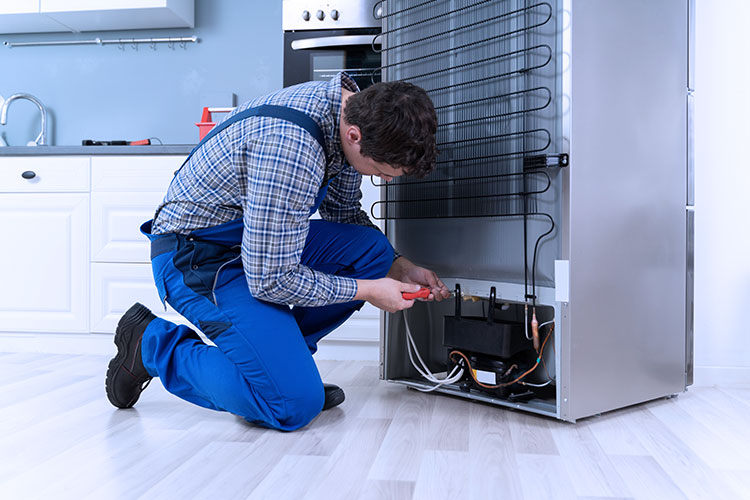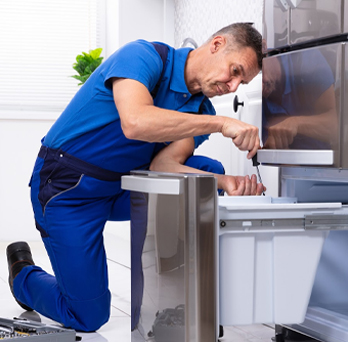Avoid Mold and Water Damage with Help from Dependable Refrigeration & Appliance Repair Service
Avoid Mold and Water Damage with Help from Dependable Refrigeration & Appliance Repair Service
Blog Article
The Ultimate Guide to Do It Yourself Device Repair Service Techniques
When appliances damage down, it's simple to really feel overwhelmed. Best Sub-Zero repair Service Dependable Refrigeration & Appliance Repair Service. With the best understanding and devices, you can tackle common issues on your own. From refrigerators to dishwashing machines, recognizing how to fix and fix these tools can save you money and time. Are you ready to find essential methods that will encourage you to deal with repair services with confidence? Let's explore the crucial locations where do it yourself skills can make a substantial difference.
Comprehending Typical Home Appliance Troubles
When you rely on your home devices, it can be annoying when they all of a sudden quit functioning or act up. Comprehending typical home appliance troubles can aid you fix issues successfully.
If your oven isn't home heating, malfunctioning aspects or thermostat concerns might be to condemn,. Dishwashers often experience issues with drainage, so ensure the filter is clean and the drainpipe pipe isn't kinked.
Also, pay attention for unusual audios; they typically suggest mechanical concerns. By acknowledging these signs, you can conserve time and potentially stay clear of costly repair work. A little expertise goes a lengthy way in preserving your home appliances, so stay informed to maintain everything running efficiently.
Important Devices for DIY Fixes
Before diving into DIY home appliance repairs, it is necessary to gather the right devices to ensure the procedure goes smoothly. Begin with a great set of screwdrivers, including both flathead and Phillips, as they're crucial for opening up most home appliances. You'll likewise desire a pair of pliers for grasping and turning cords or small elements.
Don't neglect a multimeter; it helps you test electrical parts and detect issues successfully. An outlet collection is helpful for loosening up or tightening bolts, while an utility knife can be beneficial for opening or cutting cables product packaging.
Finally, consider having a flashlight available to brighten dark rooms inside your appliances. With these essential tools, you'll be fully equipped to tackle various repairs, saving both money and time. So, gather your gear and get prepared to roll up your sleeves!
Safety And Security First: Precautions to Take
Prior to you begin any home appliance repair, it's necessary to focus on security. Make sure you wear personal protective tools, detach the source of power, and maintain your work area organized. These simple precautions can help prevent accidents and ensure a smoother repair service process.

Individual Protective Equipment
Security equipment is a vital part of any DIY home appliance fixing task. You should always wear safety goggles to secure your eyes from dust and debris. A strong set of gloves will certainly secure your hands from dangerous materials and sharp sides. Take into consideration making use of a mask if you're dealing with chemicals or dirt, guaranteeing you take a breath safely while working. Steel-toed boots are also a smart selection, particularly when lifting heavy appliances. Do not neglect to put on lengthy sleeves and trousers to secure your skin from prospective injuries. By focusing on personal protective devices, you'll substantially lower the threat of injuries and crashes. Remember, being prepared with the best gear keeps you secure and concentrated on completing your repair efficiently.
Power Source Interference
To guarantee a secure DIY appliance fixing, detaching the power source is important. Prior to you start any job, you ought to transform or unplug the appliance off the breaker. This simple step prevents electric shocks and warranties that you can concentrate on the repair without fretting about accidental activation. Always confirm that the home appliance is off by examining it with a voltage tester. If you're dealing with bigger appliances, like a washing machine or dryer, see to it to secure the power cord and prevent any kind of contact with water. Keep in mind, safety! Once you're certain that the power is disconnected, you can confidently wage your repairs, understanding you have actually taken the necessary safety measures to shield yourself.
Workplace Organization
A well-organized workplace can make all the distinction in your DIY appliance repair work task. Begin by clearing your office of mess to stop distractions and mishaps. Set out all your materials and tools, grouping similar things with each other for very easy accessibility. Make use of a tool kit or organizer to keep tiny parts like screws and washing machines contained and labeled. Ensure you have actually got adequate lighting; it'll aid you see details clearly and reduce the threat of errors. Don't forget to maintain security gear like handwear covers and safety glasses accessible. Finally, have a trash bag useful to dispose of waste immediately. A clean area not only enhances effectiveness but additionally maintains you secure while you deal with your device repair service.
Step-by-Step Guide for Fridge Repairs
When your fridge begins acting up, it can be irritating, but dealing with the trouble yourself can save you time and cash. First, disconnect the fridge to ensure safety and security. Examine for common problems like temperature level fluctuations or unusual noises. If it's not cooling down, evaluate the thermostat settings; they may be established expensive. Next, clean the condenser coils, which usually collect dirt and particles. For a noisy fridge, examine the fan and validate it's not obstructed.
If there's water merging within, check the door seals for damages i was reading this or dirt, and clean them if needed. For ice build-up, clear the defrost drainpipe. Connect the refrigerator back in and monitor it for a couple of hours once you have actually attended to the problem. If the problem persists, you may require to change a defective part, like the compressor or fan electric motor. Bear in mind, do not think twice to speak with the manual or seek expert assistance if required.
Repairing Washing Equipment Problems
Much like fridges, cleaning devices can provide their very own set of obstacles, but several issues can be solved with a little bit of troubleshooting. First, if your device will not start, check the power cord and validate it's connected in. Next, check the door latch; a faulty latch can stop the cycle from starting. If you notice unusual noises during procedure, it could be due to foreign items embeded the drum or the drainpipe pump.
If your clothes aren't getting tidy, take into consideration the water level and cleaning agent type; utilizing too much cleaning agent can develop excess suds, affecting efficiency. For leakages, examine the hose pipes for cracks or loose connections. Tightening up these can commonly fix the issue. Regular maintenance, like cleansing the filter, can avoid several issues from occurring. Keep in mind, a little troubleshooting goes a lengthy way in keeping your cleaning machine running efficiently.
Repairing Cooktops and stoves
How can you troubleshoot common problems with your stove or range? Beginning by examining the power supply.
If your oven isn't heating, evaluate the temperature setups and confirm the door seals tightly. If it's damaged., a damaged home heating aspect could additionally be the culprit; you may require to replace it.
For uneven cooking, revolve your frying pans and consider using a stove thermometer to verify precise temperatures. If you hear uncommon sounds or smell gas, transform off the device promptly and consult a professional. By complying with these actions, you can determine and fix many usual oven and oven issues effectively.
Repairing Dishwashers Facilitated
When your dish washer starts breaking down, it can be frustrating, but addressing usual concerns isn't as hard as it seems. You'll discover step-by-step troubleshooting methods that will help you pinpoint the problem, along with the important devices you'll require to take on fixings yourself. Allow's make repairing your dishwasher a wind!
Common Dishwasher Problems
While dishwashing machines are designed to make your life much internet easier, they can sometimes face typical concerns that leave you feeling irritated. One regular issue is bad cleansing efficiency; this often takes place as a result of stopped up spray arms or filthy filters. You may also notice water merging at the base, which can suggest a defective drain or a kinked hose. If your dish washer's door won't latch, maybe a basic problem with the latch system or door seal. Furthermore, unusual sounds can indicate loosened components or worn-out parts. Ultimately, if you smell something weird, it could be time to inspect for food particles or a malfunctioning electric motor. Addressing these concerns early can save you time and hassle in the future (Authorized Subzero Repair Tucson Dependable Refrigeration & Appliance Repair Service).

Detailed Troubleshooting
Prior to diving right into repairs, it's important to determine the particular problem your dish washer is encountering. If your dish washer will not begin, examine the power supply and door lock. By carefully resolving each possible concern, you can determine the trouble and take the needed actions to fix it, making your dishwasher function like brand-new once more.
Crucial Fixing Devices
Having the right devices at your disposal can make all the distinction when fixing your dishwashing machine. Do not neglect a pail or towels for any water splashes during repair work.
You might additionally want a level to ensure your dish washer's correctly straightened. With these essential tools, you'll be well-appointed important site to tackle any type of dishwashing machine repair challenge that comes your method.
Regularly Asked Inquiries
How Do I Figure out if a Device Deserves Repairing?
To identify if a home appliance's worth fixing, consider its age, repair service prices, and current value. If repair work surpass half the replacement expense, you could wish to invest in a new model instead.
Can I Find Substitute Components Locally for My Appliance?
Yes, you can frequently find substitute components in your area for your home appliance. Check equipment shops, home appliance repair service shops, or local classifieds. Do not neglect to bring the design number to guarantee you obtain the proper component!
What Typical Mistakes Should I Avoid When Fixing Home Appliances?
When repairing devices, prevent hurrying with diagnostics, disregarding security precautions, or using wrong devices. Don't avoid reviewing manuals or watching tutorials; they provide necessary support. Be person and detailed to ensure successful fixings and stop further damage.
How Lengthy Does a Normal Do It Yourself Device Fixing Take?
A normal DIY device repair usually takes one to three hours, relying on the complexity. You'll intend to gather your materials and tools initially, and follow directions carefully to prevent unneeded hold-ups.
Are There Any Type Of Warranties for DIY Device Repair Works?
When you take on DIY appliance repair services, warranties usually do not cover your work. Some manufacturers may recognize guarantees for parts you replace. Always inspect your device's service warranty terms prior to starting any repair work to prevent problems.
Prior to diving right into Do it yourself device fixings, it's important to gather the right tools to guarantee the process goes smoothly.Before you start any type of home appliance repair service, it's crucial to focus on safety and security.To assure a secure Do it yourself device fixing, separating the power resource is crucial.An efficient job location can make all the difference in your DIY appliance repair project. Constantly examine your device's guarantee terms before starting any repairs to avoid concerns.
Report this page